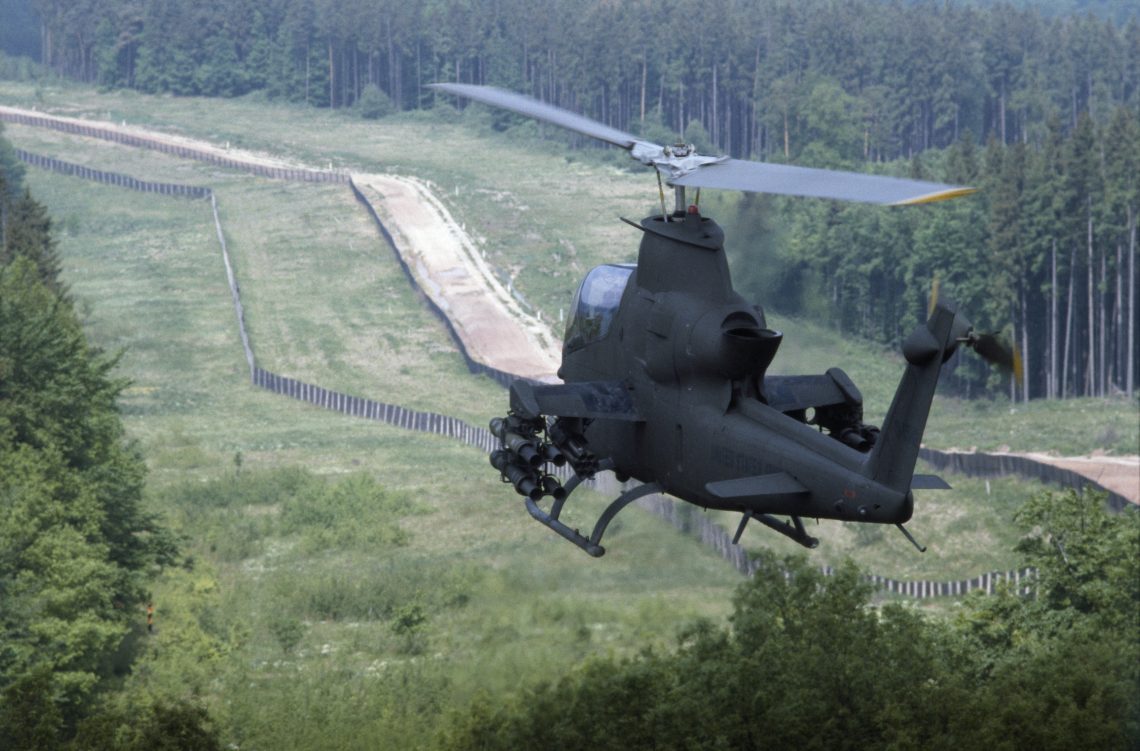Europe’s new Iron Curtain
Geopolitical tensions are causing divisions in Eastern Europe to reappear: A fortified northern bloc is emerging, driven by a resolve to deter Russian aggression.

In a nutshell
- Russian aggression has dramatically shifted Europe’s geopolitical landscape
- The new Iron Curtain divides Russia from nations it historically subjugated
- With NATO split over Ukraine support, Eastern Europe is fortifying defenses
On March 5, 1946, speaking in Fulton, Missouri, Winston Churchill delivered a speech that would resonate throughout the subsequent decades, declaring: “From Stettin in the Baltic to Trieste in the Adriatic, an iron curtain has descended across the continent.” This pronouncement marked the beginning of the Cold War era, during which Eastern Europe languished under oppressive Soviet domination.
Fast forward to May 1989, when President George H.W. Bush, addressing a vastly transformed geopolitical landscape in Mainz, Germany, proclaimed a very different vision of a “Europe whole and free.” His words were met with widespread optimism. Many believed they heralded an age of peace, even including a reconciled Russia.
Yet, here we are, 35 years later, witnessing a new Iron Curtain descending across Europe. From the northern reaches of Finland to the southern borders of Poland, this curtain is being drawn to separate Russia from the nations it has historically dominated. The catalyst? A palpable fear that Russia’s war of aggression against Ukraine may soon extend to the vulnerable frontline NATO countries.
U.S. President Joe Biden has offered assurances that NATO will defend every inch of its territory. However, his simultaneous policy of avoiding escalation with Russia has sent mixed signals. Compounding this, German Chancellor Olaf Scholz has been equally committed to not provoking Russia, leaving the frontline countries feeling increasingly anxious and compelled to voice their fears.
Fortifying borders
On June 26, 2024, the Baltic States – Estonia, Latvia and Lithuania – joined Poland in urging the European Union to establish a 700-kilometer defensive line along their borders with Russia and Belarus. Anticipating difficulties in achieving consensus in Brussels, these nations are now taking matters into their own hands.
The most visible of their actions is the construction of fortified military defenses. The borders are being secured with bunkers, trenches and fields of dragon’s teeth – concrete anti-tank obstacles to thwart rapid military incursions. Equally significant, though less visible, is the enhanced cooperation between these nations and their Nordic counterparts to bolster regional security.
More from Stefan Hedlund
- Russia’s smoke and mirrors
- The rise and fall of Russia’s Gazprom
- Prospects for a partitioning of Ukraine
At the northern end of this defensive line is Finland. Unlike many European nations, Finland did not consider the end of the Cold War a signal to disarm. Instead, it has focused on maintaining its military capabilities. With the ability to mobilize an army of 280,000 troops and possessing the strongest artillery force in Europe, Finland presents a formidable challenge to an aggressive Russia.
Conversely, at the southern end, Poland has embarked on an ambitious four-year defense project called “East Shield” (Tarcza Wschód), aimed at securing its borders with Belarus and with the Russian exclave of Kaliningrad. While Germany struggles to meet NATO’s minimum spending target of 2 percent of gross domestic product (GDP) – and is accused of cooking its books to appear to be doing so – Poland plans to increase its military spending to 5 percent of GDP in 2025, positioning itself as a central bulwark in NATO’s eastern defenses.
Economic and cultural separation
This renewed Iron Curtain is not solely about military fortifications; it is also (and perhaps even more importantly) aimed at physically and culturally separating the populations on either side. Economically, the Baltic States are pursuing energy independence from Russia, having already established facilities for importing liquefied natural gas (LNG). Following the Russian invasion of Crimea, Lithuania built an LNG terminal at the port of Klaipeda. By April 2022, the three Baltic states had become the first in Europe to cease all imports of Russian natural gas.
Moreover, on July 16 this year, it was announced that having imported no electricity from Russia for the past two years, on February 7 next year the break will become finalized: The Baltic states will not only disconnect from the Russian and Belarusian electricity grid, they will also dismantle the last remaining power lines still connecting them.
Facts & figures
Culturally, the separation translates into legal measures, including increasingly restrictive border policies and regulations targeting Russian nationals. There is an ongoing concerted effort to dismantle Soviet monuments, expel resident Russians that do not have citizenship and curtail the teaching of Russian in schools, all while diplomatic relations with Russia are being scaled back.
The likely outcome of this geopolitical schism will be the formation of a northern bloc within NATO, unified in its conviction that Russia’s war of aggression against Ukraine must end in Moscow’s defeat – though precise definitions of “defeat” may differ. The Nordic and Baltic nations, leading the charge in the provision of military aid to Ukraine (at least in terms of aid as a percentage of GDP), have also firmly rejected the “escalation management” policies of Germany and the U.S.
Spurred on by Kaja Kallas, Estonia’s hawkish former prime minister and now newly appointed EU High Representative for Foreign Affairs (the EU’s “foreign minister”), a wave of political leaders across the region are advocating for a resolute stance against Russian aggression. Danish Prime Minister Mette Fredriksen has enthusiastically supported Ukraine, pledging all of Denmark’s artillery and subsequently donating all its air defense assets to Ukraine. Danish F-16 jets are also poised to take to the air in Ukraine.
The Baltic-Nordic defense coalition, also encompassing Poland, has also garnered strong support from the Czech Republic, the Netherlands and the United Kingdom. Czech President Petr Pavel has scoured international markets to procure desperately needed artillery shells for Ukraine, while the Dutch have led efforts to provide advanced military hardware, including German-made Leopard tanks and U.S.-made F-16 fighter jets.
Divided NATO
The Nordic-Baltic bloc of countries are not the only NATO states to be firm military backers of Ukraine – throughout, the UK’s support has been unwavering, with former Prime Minister Boris Johnson quick to rally to Kyiv’s defense. And while Germany has announced that it will slash its support for Ukraine in half in 2025, the UK has announced it will double its aid. Symbolically, when newly elected Prime Minister Sir Keir Starmer held one of his first cabinet meetings, he invited Ukrainian President Volodymyr Zelensky to sit at the table, between himself and new Secretary of State for Defense John Healey.
Nevertheless, what makes the new Iron Curtain fundamentally different from the old is the evident division within NATO. Despite the atrocities Russia has committed in Ukraine, nations such as Hungary remain steadfast in their pro-Russian stances, while others, like Germany, still hope for a negotiated solution and a speedy return to business as usual. These fractures play directly into the hands of the Kremlin, enhancing its belief that its war against Ukraine may still be won and that the West can be fragmented and weakened.
So serious are the security concerns, other European capitals have begun exploring the possibility of introducing border controls against Hungary.
Hungary has not only maintained its energy imports from Russia but has obstructed the provision of funds and weapons to Ukraine, and consistently sought to block all EU decisions that might hurt Russia. Prime Minister Viktor Orban’s opening pro-Russian sentiments are matched by Foreign Minister Peter Szijjarto’s frequent visits to Moscow, where he reportedly enjoys a personal rapport with his Russian counterpart Sergei Lavrov.
Embracing the prospect of a second presidency for Donald Trump, and of a new world order dominated by men like Vladimir Putin and Xi Jinping, Mr. Orban started his tenure as chair of the European Council by launching a “peace mission,” bringing him from Kyiv to Moscow, then Beijing, and ultimately Mar-a-Lago in Florida to meet with Mr. Trump.
Then, at the end of July, Budapest upped the ante by announcing the introduction of a “National Card” permitting guest workers from Russia and Belarus into Hungary – and thus into the Schengen area – without proper screening. The move effectively sidesteps rigorous entry checks and creates channels for Kremlin agents of influence and espionage (as well as professional assassins) to infiltrate Europe undetected. So serious are the security concerns, other European capitals have begun exploring the possibility of introducing border controls against Hungary.
Scenarios
Onward developments could diverge into two starkly contrasting scenarios.
Less likely: A European ‘bloc of deterrence’ forms
In one, the Baltic-Nordic-Polish bloc is joined by Romania, another staunch supporter of Ukraine that by 2030 will host the largest NATO base in Europe. Bolstered by support from the Czech Republic, the Netherlands and the United Kingdom, with the latter adding a nuclear component, this grouping would wield sufficient military strength to offer effective deterrence against Russian aggression, and sufficient political resolve to ensure that deterrence is credible.
Such concerted action by this group might inspire other European countries to follow their example, resulting in a united Europe that is firm in maintaining support for Ukraine and sanctions on Russia until the war is over. However, the undertaking could be laden with controversy: Facing Kremlin cheerleaders making vociferous accusations of Russophobia, it could incite demands that sanctions be lifted and relations with Russia normalized.
Most likely: The pro-Russia bloc prevails
Conversely, a radically different scenario envisions the Kremlin being proven right in its belief that Western support for Ukraine will crumble and that a pro-Russian bloc of countries will force Ukraine into a negotiated end to the war – on Russian terms. Hungary and Slovakia could spearhead this push, while Germany and France, burdened by domestic pressures, might capitulate passively to Kremlin demands for negotiations.
The crucial dynamic at play involves the rising influence of political parties on the extreme right and left that are united in their support for Russia. In Germany, opinion polls for the next Bundestag election, expected in September 2025, show major gains for parties that openly favor normalizing relations with Russia. And following its latest elections, France is already politically gridlocked and may be looking at Marine Le Pen winning the presidency in 2027. There is plenty of evidence of Russia lending active support to such parties.
This noted, it is Hungary that may trigger a real crisis. In addition to maintaining warm relations with Moscow, and its active sabotage of the Schengen agreement, it has also concluded an agreement with China that allows Chinese police to patrol in Hungary alongside their Hungarian colleagues. Concern has been raised in some quarters that in a crisis, Budapest might even allow China or Russia to station troops in Hungary – that is, inside NATO. Given that Brussels is unlikely to reimpose discipline on Hungary and Slovakia, the outlook is for continued fragmentation within the EU, which will delight the Kremlin.
Somewhat likely: A stronger U.S. stance
A wild card remains: the evolving posture of the U.S. The Ukrainian incursion into Russia launched on August 6 has utterly discredited the policy of “escalation management.” If U.S. Vice President Kamala Harris is elected president and proceeds to lift all restrictions on the use of Western weapons, then the tide of the war may again turn against Russia.
With solid backing from the U.S., and with the Baltic-Nordic-Polish bloc also remaining steady, Ukraine may still emerge victorious, and the new Iron Curtain will drop firmly into place. While there are many remaining caveats – especially concerning the onward roles of Germany and France – the odds in favor of this outcome are improving.
For industry-specific scenarios and bespoke geopolitical intelligence, contact us and we will provide you with more information about our advisory services.








